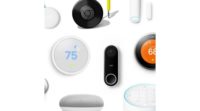Last month, I had the unique pleasure of attending the 2020 CES Show in Las Vegas as a part of the Consumer Technology Association’s Media Trailblazers Program. Designed for early career journalists who have never been to the show, this gave me the opportunity to spend Jan. 6-9 in sunny Las Vegas, walking the 2.9 million square feet of show floor at the world’s largest tech event.
There are a wide variety of marketplaces represented at CES every year — 5G connectivity, artificial intelligence, augmented and virtual reality, smart cities, vehicles, and digital health being just some of them. And while the largest crowds mostly formed around the bizarre, there was also quite a bit of buzz around the innovative security products in the smart home and video sections of the show.
As a CES first-timer, I was blown away by all that I saw — particularly in the smart home. Many exhibitors, such as the Z-Wave Alliance and Google, had full smart homes on display to show how different connected technologies work together. It made it seem as if a future where everyone is bossing their homes around — telling Alexa that you want your blinds drawn, or your lights dimmed or whatever else you could dream of — is not very far off.
When you look strictly at the security products on display, there was one very obvious trend, which proved that maybe the security industry isn’t such a dinosaur after all. Everywhere you looked, companies were offering well-thought out solutions to a problem that has made national news: bad actors hacking video surveillance cameras.
Perhaps the most impressive of these solutions comes from one of the oldest “dinosaurs”: ADT. Proving itself as a leader in this industry, the company rolled out its own DIY surveillance offering. Blue by ADT is a flexible, extensible DIY system that allows customers to customize a smart home security system on their own terms, with no long-term contracts required. To further target the market that Amazon and Google have sunk their teeth into, Blue by ADT owners can either self-monitor, or receive 24/7 professional monitoring from ADT.
And ADT didn’t stop there — they made sure their Blue Doorbell Camera was superior, or equal, to the Ring Video Doorbell 2, Skybell HD and Nest Hello in virtually every way. Its field of view is 180 degrees; it has facial recognition capabilities; it integrates with Amazon Alexa, IFTTT, Apple HomeKit and Google Assistant; the camera costs the same or less than them all; and cloud storage is $2.99 per month compared with Ring’s $3 rate.
There were also quite a few newcomers attempting to become the million-dollar solution to Ring’s woes. The Kangaroo Privacy Camera touts a PDLC Glass Privacy Shield which can shut down both the camera and the mic, taking them offline and inaccessible from prying eyes and ears. The SimCam 1S processes data with artificial intelligence only on the device, protecting user privacy with bank-level encryption. spexor — a product of Bosch’s start-up platform — is a mobile warning device that detects break-ins in various environments. Without any sort of camera, spexor sensors monitor pressure, noises and movement to detect an intrusion.
So while Amazon and Google may have disrupted our industry, maybe they have made us better, forcing us to create new and innovative technologies that keep consumers and their data truly safe and secure.





